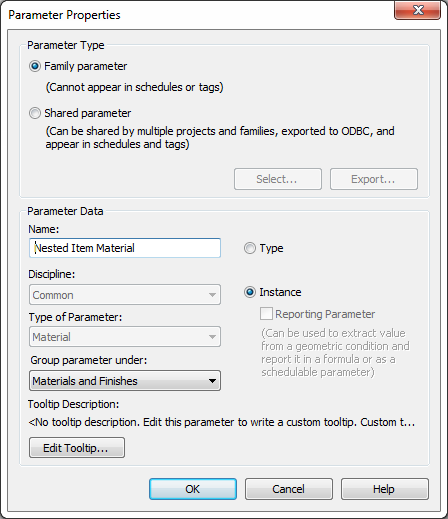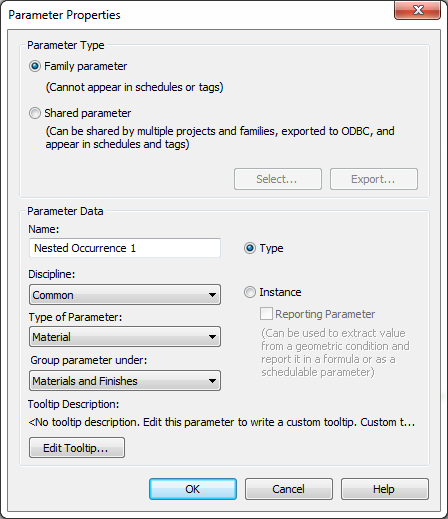Revit Host Face of Family Paint Material Parameter
Being able to control the displayed materials and finishes of nested families is an of import role of creating circuitous Revit families. As families are created to provide more options or be more efficient, boosted families are created and placed into a Host family. The use of Nested families has a couple of key advantages:
- When the same component is used multiple times in a family, it can be advantageous to make that component a Nested family. An example of this is a cycle assembly family that is used four different times for a cart.
- When a family needs to have multiple options from which the user can cull. An example of this is a door assembly that has various door console family unit options, such equally full drinking glass, half glass, solid, etc.
Before I go any farther, I want to analyze the departure between a Host family unit and a Nested family. A Nested family is one that exists inside another family unit. For example, when family F1 is loaded into F2, F2 is the Host family unit and F1 is the Nested family unit. Typically, F2 is then loaded into the Revit project file.
Anyhow, as you create a family unit with Nested families, you want to be able to control the materials and finishes of those Nested families straight in the Host family Properties palette after it has been placed in the project file. For instance, yous may want to command the cloth/finish/color of a door panel that is actually a nested family unit in a door associates. If you don't set the family up correctly, you volition non be able to exercise this without opening the door panel family and changing it in the family editor. You practice Non want to be required to practice this.
Permit's take a look at the steps involved in doing this process.
In the Nested family:
- Open up the family that will exist the Nested family.
- Add a material parameter as an Instance parameter. In this example, the parameter is named "Nested Item Cloth".

- Highlight the Form component(due south) (extrusion, alloy, revolve, sweep, etc) that will take the aforementioned material assigned to them. Many different components tin can be assigned to the same material parameter.
- With the components highlighted, go to the Properties palette and pick the button to the right side of the Material parameter. (Do Not choice the box that says "<By Category>".)

- When the Acquaintance Family Parameter dialog box appears, select the cloth parameter that you created. In this example, the parameter is named "Nested Item Fabric". Choice the OK push button.
- Repeat steps two through 5 for each different material parameter that is needed. This allows for situations similar to the cycle assembly mentioned earlier where the wheel portion is one fabric and the subclass portion is a different textile.
In the Host family:
- Load the Nested family into this Host family.
- Add a material parameter as either a Type parameter or an Example parameter, depending upon the control which you desire in a projection file.. In this case, the parameter is named "Nested Occurrence one".

- Highlight the Nested family.
- With the Nested family highlighted, get to the Backdrop palette and selection the push button to the right side of fabric parameter name that is contained in the nested family, which is "Nested Particular Material" in this example . (Exercise NOT option the box that says "<By Category>".)

- When the Associate Family Parameter dialog box appears, select the material parameter that you created. In this example, the parameter is named "Nested Occurrence ane". Option the OK button.
- If the Nested family unit contains multiple textile parameters, repeat steps 3 through 5 for each nested fabric parameter.
- Repeat steps ii through half dozen for each occurrence of the Nested family in the Host family.
Notes:
- If Shared Parameters are used for the parameters then they can be used in tags and schedules. I tend to make well-nigh parameters similar this be Shared Parameters so that I practise non limit scheduling capability in the future.
- If the parameter in the Nested family is specified as an Instance parameter, each occurrence of the Nested family in the Host family can take dissimilar materials assigned to the same material parameter for each unlike occurrence of the Nested family. (In the four wheel case, each wheel could have different materials.)
- The fabric parameter in the Host family also needs to be an Case parameter for this to piece of work this way.
- If the parameter in the Nested family is specified as a Blazon parameter, each occurrence of the Nested family in the Host family will have the same textile assigned to each occurrence of the Nested family.
- The Nested family may also be loaded into a project file, simply if information technology is directly inserted in a project file then it is not a Nested family for that occurrence in the project file.
Source: https://aectechtalk.wordpress.com/2015/08/19/controlling-material-of-nested-revit-families/
0 Response to "Revit Host Face of Family Paint Material Parameter"
إرسال تعليق